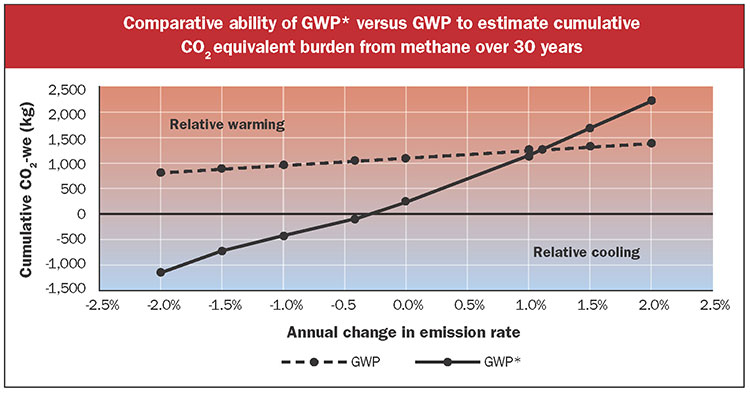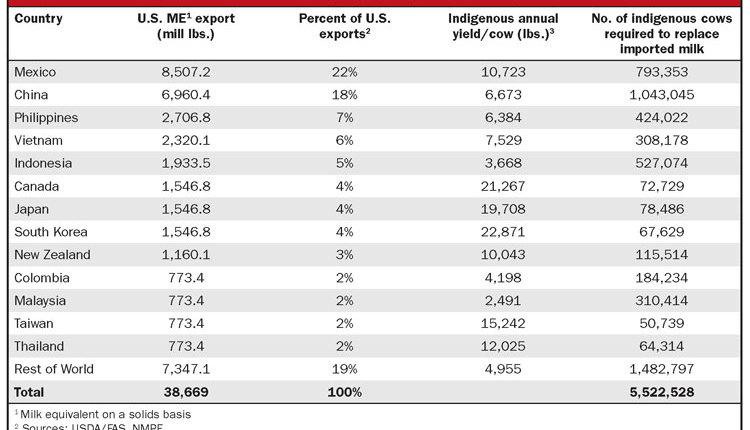Cattle have been converting grass and other forages into high-quality milk, meat, and fiber, and used as draft animals, pulling heavy loads for humans, for roughly 10,000 years. They have been able to do this because their rumen converts plant matter inedible to humans into nutrition for the ruminant’s body. However, the story doesn’t end there. A by-product of this conversion process is methane.
Methane is a powerful greenhouse gas (GHG) that contributes to global warming. Consequently, critics have reasoned that cattle pose a significant environmental threat and urge us to eat less beef, consume less milk, and convert grazing land into human food cropland to reduce cattle numbers. However, GHGs do not all have the same capacity to warm the atmosphere. Their ability to capture solar energy differs, and their atmospheric lifetimes vary considerably. These intrinsic characteristics are the main determinants of their atmospheric warming ability.

Methane is potent
In 1990, the U.N. Intergovernmental Panel on Climate Change (IPCC), the leading global authority on GHGs, introduced a metric called “global warming potential” or GWP to compare the global warming ability of various GHGs. Carbon dioxide (CO2) is the major GHG in the atmosphere and continues rising at the greatest rate. Therefore, the GWP of all other GHGs are referenced to the GWP of CO2, which is defined as one.
Methane is much scarcer than CO2; however, its ability to capture solar energy is much greater. The latest estimate for methane’s GWP from cattle is 28. This means a 1-pound emission of methane is 28 times more potent than a 1-pound emission of CO2.
Climatologists have known GWP has shortcomings. Most importantly, with respect to comparing methane to CO2, there is an inference that methane persists in the atmosphere for a long time. Methane’s atmospheric lifetime is approximately 12 years, compared to CO2, which has a lifetime of centuries. Comparatively speaking, methane is a “short-lived climate pollutant” (SLCP), whereas CO2 is a “long-lived climate pollutant” (LLCP).
An LLCP acts like water flowing into a tub that has a faucet but no drain. No matter how slowly water flows in, the tub keeps filling until the faucet is shut off.
Conversely, an SLCP acts like water flowing into a tub that has a drain. Depending on the outflow and inflow rates, the tub may fill, stay level, or drain. This is a critical difference when determining the warming effect of methane compared to CO2, which the current definition of GWP fails to fully capture.
Scientists at the Environmental Change Institute and the Food Climate Research Network (FCRN), led by Myles Allen of Oxford University, have recently submitted a proposal to IPCC for the acceptance of a new metric called GWP*. Instead of comparing the warming potential of a GHG against an equal mass of CO2, GWP* compares an emission pulse of CO2 to a change in the emission rate of an SLCP. In so doing, GWP* does a better job accounting for the difference in atmospheric lifetime between CO2 and methane and provides a more accurate estimate of the warming effect of methane over a period of years.
A visual perspective
The graph compares the ability of GWP and GWP* to estimate cumulative climate effect of methane, measured as CO2-equivalent (CO2-e) and CO2-warming equivalent (CO2-we), respectively, over 30 years given various changes in its annual emission rate. The graph is based on an initial 1 kilogram (kg) emission of methane followed by an annual change in emission rate from a 2% decrease to a 2% increase (x-axis). The estimated accumulated CO2-e and CO2-we for 30 years (y-axis) is compared between GWP and GWP*. Terms “r” and “s” are internal factors in the GWP* calculation.
Notice estimates of accumulated CO2-e burden when using the GWP calculation (dotted line) are always positive even when the annual methane emission rate is falling. In fact, using GWP implies that global warming from methane will never cease climbing unless all emissions of methane stop. This is a fallacy, because we know if methane emissions simply remain constant, its atmospheric warming effect will eventually stabilize due to its short atmospheric lifetime.
The GWP* response provides quite different information. A previously unrealized and exciting effect is a relative cooling effect exists when methane emissions drop more than 0.4% annually. This effect can offset other concurrent GHG emissions. Between a 0.4% annual decrease and no change (0%) in methane emissions, there is some CO2-we accumulation; thus, a small relative warming effect due to a 10-year lag by the atmosphere to react to emission rate changes.
Moving to the right, at an annual emission increase of approximately 1.1%, GWP provides an equal estimate of CO2-we burden to GWP*. However, as annual emissions grow at a greater rate, GWP* estimates are greater than GWP estimates. Therefore, not only is GWP insufficient to predict relative cooling effects when methane emissions fall, it is also insufficient for predicting warming effects when methane emissions rise.
What it means for dairy
Adoption of GWP* by the IPCC will have significant effects on results of environmental assessments of cattle. The global cattle population has been growing about 0.5% annually since 1990. Therefore, we can expect global cattle methane emissions also have climbed approximately 0.5% given all other variables are constant. Assessing the effect of these increased methane emissions using GWP*, the accumulated CO2-we would only be 60% of the GWP estimate.
In countries like the U.S., where improved health, genetics, feeding practices, and technology have enhanced the efficiency of producing milk and beef, total methane emissions from national cattle populations have diminished and most likely contributed a relative cooling effect, offsetting the warming effect from other GHGs since the late 20th century. These global and regional trends could result in a shift of the percentage of global methane warming effects from cattle to industrial sources such as fossil fuels where methane emissions are significantly increasing.
The GWP* metric is a significant development providing substantial improvement for estimating global warming effect of methane. However, it is not an excuse for cattle owners to dismiss their responsibility to curb their share of GHG emissions. The cooling effect persists only if methane emissions continue falling more than 0.4% annually.
Actionable options exist
There are proven ways to reduce all livestock GHG emissions per unit of food produced, including anaerobic digesters, and improving animal health and productivity as U.S. dairy farmers have been doing for decades. Furthermore, there is promising research ongoing to develop technology that directly reduces enteric methane emissions without adversely affecting productive efficiency.
Stay tuned.








